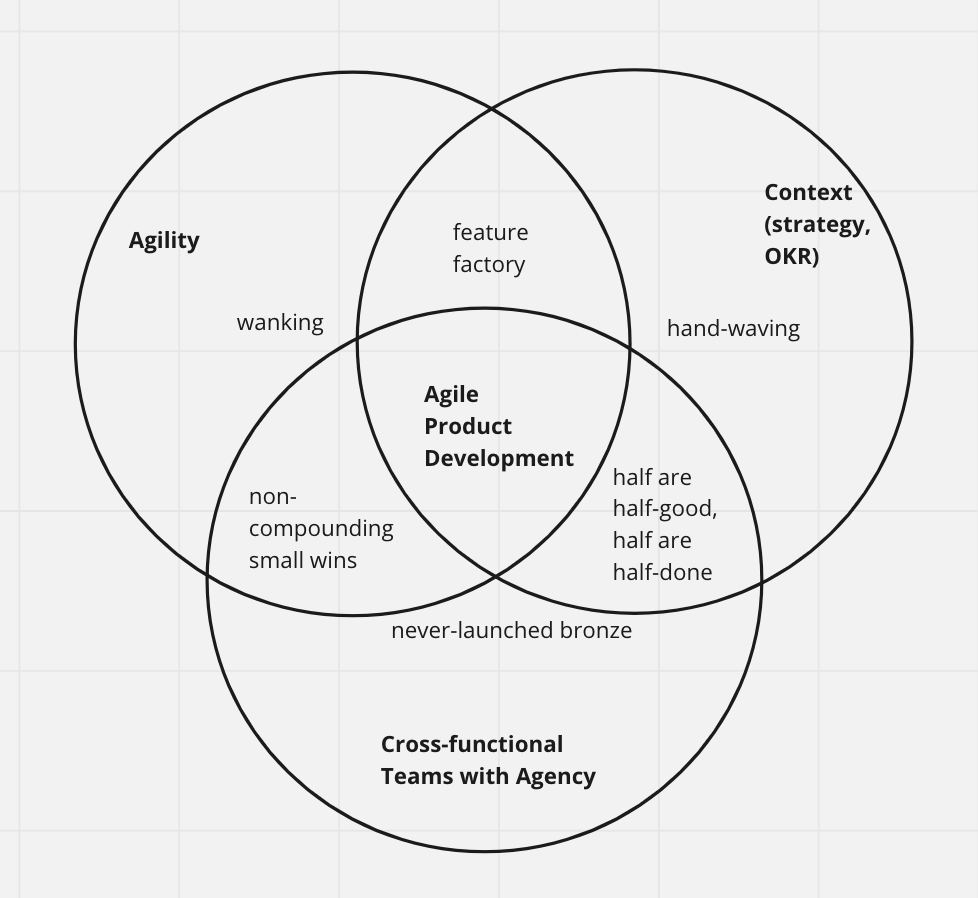Agile Product Development
Traditional "management", even most software product management, is Industrial-Age Command-and-Control thinking that is net-negative for managing creatives. We need a re-framing of Agile Software Development with a business-building software Product Development mindset. Rapidly Iterative based on FeedBack. A bit post-Lean-Startup. Product-Led, Customer-Driven.
Related pages: (note they overlap and aren't fully consistent, I have to do some refactoring!)
- pre-Product-Market Fit: Adding Product To Your Startup Team, Product Management from MVP to Product-Market Fit
- Project-oriented Roadmaps are counter-productive for Software Product Teams
- Agility, Context, and Team Agency
- Agile Software Development, Extreme Programming
- Strategic Context
- Quadruple-Loop Product Management, Data-Informed Product Management
- Whole Team, Product Team: Product Team Members Report To The Team Leader
- Gardening Your Product Process
- Growing Your Startup Tech Product Team,
- My Product Development Process
- Pair-Product-Managing
- Co-Creating a Mid-Sized Product Org Change
- case-study: Building a User Success Legibility Funnel
- cf Org Writing Practices
- (2022-10-12) Accidental Learnings of a Journeyman Product Manager
Context/disclaimer: this focuses on internet-software products. I'm confident it scales up to 10 teams, I'm not as confident above that. Most pages are a better fit post-Product-Market Fit.
Short version
- execs create/maintain coherent strategic context
- execs design product boundaries/charters; set OKRs
- execs create product teams with agency, each having a single leader
- expect Teams to create north star metrics, continuous discovery, continuous delivery based on thinking in bets
I sometimes frame this as Flow-based Product Development.
- But that's not like Principles Of Product Development Flow, more about maximizing Flow State. Trying to create momentum, compounding.
- Though there's a risk of being biased toward incrementalism within a mis-designed product strategy (congruence bias).
- So it has to be reflective, iterative (reflective thinker).
- Maybe a Bottleneck framing integrates those perspectives?
Mindset/worldview
Agility, Context, and Team Agency

CheckList/Manifesto
mimic Agile Manifesto in structure/format
- congruent multi-layered strategic context over planning theater (hand-waving and wishful thinking)
- compelling customer pains over complicated solutions
- incremental/iterative continuous discovery/thinking in bets over roadmaps and market research
- whole teams with agency over matrixed committees
inspired mainly by
- Martin Cagan: posts on top-down pre-requisites (Agility, Context, and Team Agency); sources of failure (2015-06-05) Cagan Product Fail
- Ron Jeffries: esp Nature Of Software Development and (2019-09-16) Jeffries Twelve Talk
- Clarke Ching (scope-splitting on bottleneck, see Rolling Rocks Downhill)
- Teresa Torres: Opportunity Solution Tree, Continuous Discovery
- John Cutler: general pragmatic/human-centered product management
- Ash Maurya's Running Lean
- SciFi for Product People :)
The bits below which I've structured as Patterns (or Anti-Patterns) are in bold.
Positive
Strategic Context: Mission/Vision/Lean Canvas -> Product Vision/Product Strategy (Market Segment) -> OKR
- Quadruple-loop Product Management, Data-Informed Product Management for Thinking in Bets
- Continuous Discovery for OODA for Compounding value.
Product Team Members Report to the Team Leader.
Development Queue driven by BottleNeck-oriented OpportunitySolutionTree.
Agility: Every team can deploy multiple times per week. Near-Continuous Delivery.
Negative (Product Management Theater)
RoadMap: Project-oriented Roadmaps are counter-productive for Software Product Teams
Big Projects ("Product Projects should be Cattle, not Pets") (hah note "Pet Project" AntiPattern)
Edited: | Tweet this! | Search Twitter for discussion
No Space passed/matched! - http://www.wikiflux.net/wiki/AgileProductDevelopment... Click here for WikiGraphBrowser
No Space passed/matched! - http://www.wikiflux.net/wiki/AgileProductDevelopment

 Made with flux.garden
Made with flux.garden